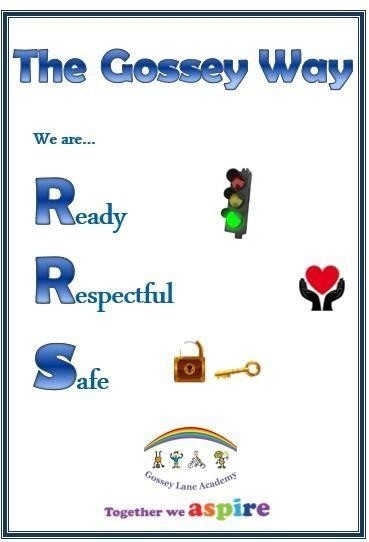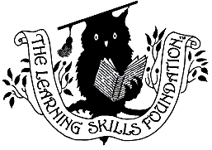- Home
- Parents
- Behaviour Procedures
Behaviour Procedures
The Gossey Way
At Gossey Lane we expect all our children to embrace the Gossey way of life. There are three key rules which we expect all children, staff and visitors to follow.
We are:
- Ready
- Respectful
- Safe
Gossey Lane community values diversity and seeks to give everyone in the school an equal chance to learn, work and live, free from the action, or fear, of racism, discrimination, or prejudice. By our actions we will work together to develop the potential of all children and to establish a community that is just and fair for all people who work at or visit Gossey Lane Academy.
At Gossey Lane we value good behaviour in the classroom and elsewhere to promote the school as a learning community and to ensure that classrooms are safe and effective learning environments. The highest regard is given to the quality of relationships between staff and children. We seek to develop independent and autonomous young people who are self-disciplined and who are able to self–regulate and manage their behaviour.
The Young People Advocate will contribute to school life on a wider scale, acting as a critical friend to support the school in becoming a nationally recognised centre of excellence.
Aims
We believe that all children should be aware of the standards of behaviour that are expected of them and that working with children we will help them to take responsibility for promoting these standards. We hope that by encouraging positive behaviour patterns we can promote good relationships throughout the school built on trust and understanding, and that through the use of this policy we can support all of our children in developing a high level of individual and social responsibility. The aims of this document are:
- To create a culture of exceptionally good behaviour: Ready For Learning and Ready For Life
- To ensure that all learners are treated fairly, shown respect and to promote good relationships
- To use “affective language“ which encourages the learner to engage positively and understand the impact of their behaviour. We use impersonal language and all staff are trained in de-escalation techniques for dealing with challenging behaviour.
- To help learners take control of their behaviour and be responsible for the consequences of it
- To build a community which values kindness, care, good relationships and empathy for others
- To ensure that excellent behaviour is a minimum expectation for all
Standards of behaviour
The school understands that modelling good behaviour is to lead by example. This means that all staff, volunteers, and other visitors must act responsibly and professionally. We work hard to ensure that discipline is consistent across the school so that behaviour boundaries and sanctions are clear to all and are applied fairly, proportionately, and without discrimination, taking into account SEN needs and disabilities, as well as the additional challenges that some vulnerable children may face. Staff are trained to deal with behavioural issues as part of their continual professional development.
We work with parents to understand their children and their behaviour. We believe that in conjunction with behaviour boundaries and sanctions, good support systems, praise, and rewards for good behaviour are all an important part of building an effective learning community. The school will report behaviour, good or bad, to parents regularly. We encourage parents to communicate with the school if they have a concern about their child’s behaviour, and we will do as much as possible to support parents as and when they need it. We promote good behaviour within the school curriculum and reminders of expected standards of behaviour are up on walls in classrooms and situated around the school.
Staff must be a constant presence around the school, in-between classes, during breaks in the school day, and at lunch times in order to check that children are using the school grounds respectfully and behaving appropriately. This will support the building of positive relationships outside the classroom.
We recognise that where individual children are engaging in continuing disruptive behaviour this can be as a result of mental health needs. If such needs are identified we will do all we can to ensure that the pupil receives appropriate support. We recognise our legal duties under the Equality Act 2010 in respect of children with SEN and/or disabilities. Whilst all children identified with SEN and/or disabilities are covered under this behaviour policy, we recognise that these children often require support which is different from, or in addition to, that required by their peers in order to take full advantage of the educational opportunities available to all children. An Individual One Page Profile will be used for children who’s SEN and/or disabilities cause them to display challenging behaviour.
Advice will be sought from external agencies where necessary to assist with putting in place appropriate support strategies, which will be monitored and reviewed. Please read the school’s special educational needs policy for more information.
The school will take all reasonable measures to ensure the safety and wellbeing of all children and staff and this includes protection from bullying. We aim to combat bullying and other harmful behaviour using, amongst others, preventative strategies through the active development of children’s social, emotional and behavioural skills.
Working with Children
Gossey Lane Academy expects all children to show respect to one another, to school staff, and anyone else that they may meet. Incidents of bullying, denigration, or bringing intentional harm to other children or staff will not be tolerated. Children are ambassadors for our school including when travelling to and from school premises, and we expect them to act accordingly. They are expected to obey school rules, listen and follow instructions and demonstrate the Gossey Values. School work and homework should be well presented, completed to a high standard, and handed in on time. If children are struggling to meet the requirements of their workload for any reason, they should discuss this with their class teacher who will work with them to draw up a support plan.
Key steps and actions in tackling behaviour
The expectation - All children will begin the morning and afternoon sessions with a fresh start. This gives them the opportunity to show that they can follow The Gossey Way. This gives the children opportunities to receive praise and rewards for their conduct.
Redirection - If a child is not following the expected behaviour they are given a non-verbal reminder of expected behaviour. This is a gentle ‘nudge’ in the right direction.
Reminder - a reminder of expectations. Ready, Respectful, Safe delivered in private. Repeat reminder if necessary. De-escalate and decelerate where reasonable and possible and take initiative to keep things at this stage.
Warning - Further unacceptable behaviour means that the adult gives the child a verbal reminder. This should be a clear verbal caution delivered privately wherever possible, making the learner aware of their behaviour and clearly outlining the consequences if they continue.
Reflect – At this point the adult must allow time for the child to ‘put it right’. However, the child should have ‘put it right’ within a reasonable time and normally before the end of the lesson. The teacher may choose to send the child for a ‘cool down’ period to another class. The classes are allocated on our behaviour ‘cool down’ time flowchart. After returning from the partner class, the child has the choice to ‘put it right’. If the child chooses not to, a member of SLT will be sent for (as per the ‘H’ card procedures below).
Reparation – A Restorative meeting and/or phone call home should take place within 24 hours. This is to inform the parents of any behaviour concerns or repeated, negative behaviour patterns and build a positive partnership to tackle concerning behaviours. Senior leaders will contact parents if the behaviour is a high concern following a serious breach.
Formal – A meeting with the Behaviour Lead, Deputy Head or Head teacher recorded with agreed targets that will be monitored/reviewed on a two week basis.
Behaviour Intervention – For children who are causing continued low level disruption but having high learning impact on themselves or others, behaviour target cards will be put in place to support the pupil by lesson. These may be part of a One Page Behaviour Profile or a short term, stand-alone intervention. Class teachers will at the end of each session, praise children and explain what they have done well, or ensure the pupil understands how they can improve their behaviour. At the end of the day there will be a delegated member of the Pastoral or Senior Leadership Team who will discuss the behaviour progress for that day.
Our School Rules: Ready, Respectful, Safe
Ready
- We arrive at school on time, every time ready to learn.
- We are ready to take on new challenges.
- We are ready to listen and learn.
- We wear our uniform with pride and have all the correct uniform for indoor and outdoor P.E.
- We take part fully in lessons and show resilience.
Respectful
- We respect, follow and demonstrate Gossey Values.
- We are respectful to our own and others belongings.
- We respect difference and know we are all equal. (Rights Respecting)
- We look after our environment and never drop litter.
- We are polite and show our manners at all times.
Safe
- We know who to talk to for help and support.
- We stand up to bullying of all kinds including staying safe online.
- We follow instructions carefully.
- We know how to stay safe online both in school and at home.
Rewards and Sanctions
We want our children to understand that there are always consequences to our actions, therefore we have both positive and negative consequences, according to our behaviour choices. School dojos are the main reward system in the school and all adults will reward children with dojos for their good conduct and efforts. Excellent behaviour, which goes beyond the general high expectation, should be rewarded.
Rewards and sanctions must be age appropriate and should reflect the level of behaviour. They must be attainable for all pupils and not just for a selected few. Rewards once issued will never be taken away from a child.
Rewards
We want all of our children to aim to be a ‘Gossey Great’ and go ‘Above and Beyond’. If a child is given a Gossey Great Award, they will receive a certificate during the Gossey Great assembly.
Specific rewards include:
- Points awarded on Class Dojo for excellent behaviour and demonstrating ASPIRE values and learning behaviours.
- A written comment on work with specific points picked out for comment
- An individual award e.g. Sticker or note of praise home
- A visit to a more senior member of staff for positive commendation
- A public word of praise in front of a group, class, key stage or the school
- Public written acknowledgement through good Gossey Great assemblies
- School Certificates, formally presented (including learning behaviour certificates) Rewards are not taken away from a child once awarded.
Sanctions
Section 91 of the Education and Inspections Act 2006 introduced a statutory power for teachers and certain other staff to discipline children. Gossey Lane Academy operates using the following disciplinary measures:
- Homework Support for non- completion
- Supervised Attendance (internal isolation)
- Fixed Term Exclusions/Permanent Exclusions
- Target Cards
- One Page Behaviour Profiles (BOPS)
- Parental meetings
- Reduced timetable
Consequences are proportionate. In determining whether a consequence is reasonable, section 91 of the Education and Inspections Act 2006 says that the consequence must be reasonable in all circumstances and that account must be taken of the child’s age, any special educational needs or disability they may have, and any religious requirements affecting them.
In addition, a referral to Beacon Behaviour Support may be carried out to support children who are struggling to meet the expectation for behaviour. We will also complete Positive Handling Plans and Risk Assessments for children. Sanctions are adapted relating to the seriousness and frequency of the behaviour. (Article 37 – Rights of the Child)
Restorative Practice
If a pupil makes a negative choice about their behaviour they will have some reflection time where they will be supported to think about their actions, how this affected others, and how they can make better choices next time. During restorative conversations children will have the opportunity to give their version of the incident and will be listened to by the adult. (Article 12 Rights of the child)
Staff are expected to record the restorative conversations they carry out on CPOMS and cannot pass the conversation on to someone else. They must ensure parents are reported to where conversations are having to be held on a regular basis. The behaviour Lead must be consulted if staff wish to raise a concern and where an intervention is required.
A serious breach is an incident that may lead to a fixed term exclusion or internal exclusion but will always lead to a Restorative Conversation.
Working with Parents and Carers
Parents play a big part in ensuring that their children are responsible for their own behaviour in school. We ask that all parents and carers respect and support the school’s policy and the authority of the school staff. This can be done by:
- Building school life into a natural routine
- Ensuring that children are at school on time, appropriately dressed, rested, and equipped
- Encourage children to adhere to school rules and procedures
- We ask parents to work with the school in support of their child’s learning, which includes informing the school of any special education needs or personal factors that may result in their child displaying unexpected behaviour. We ask that parents be prepared to attend meetings at the school with staff or the Head teacher to discuss their child’s behaviour and to adhere to any parenting contracts put in place.
- In the case of exclusions, parents must provide appropriate supervision for their child during the time that they are excluded from school and, if invited, to attend a reintegration interview at the school with their child.
Bullying at Gossey Lane Academy is very rare and is always taken very seriously. Please follow this link to find out more about our approach to anti-bullying.
Gossey Lane Academy follows the KiVa Programme.
Links with other policies
This behaviour policy is linked to the following policies:
- KCSIE 2023-2024
- WHMAT Safeguarding Policy
- Attendance Policy
- Gossey Lane SEND Policy
- Gossey Lane Anti-bullying Policy
The Gossey Way
Ready, Respectful and Safe
















